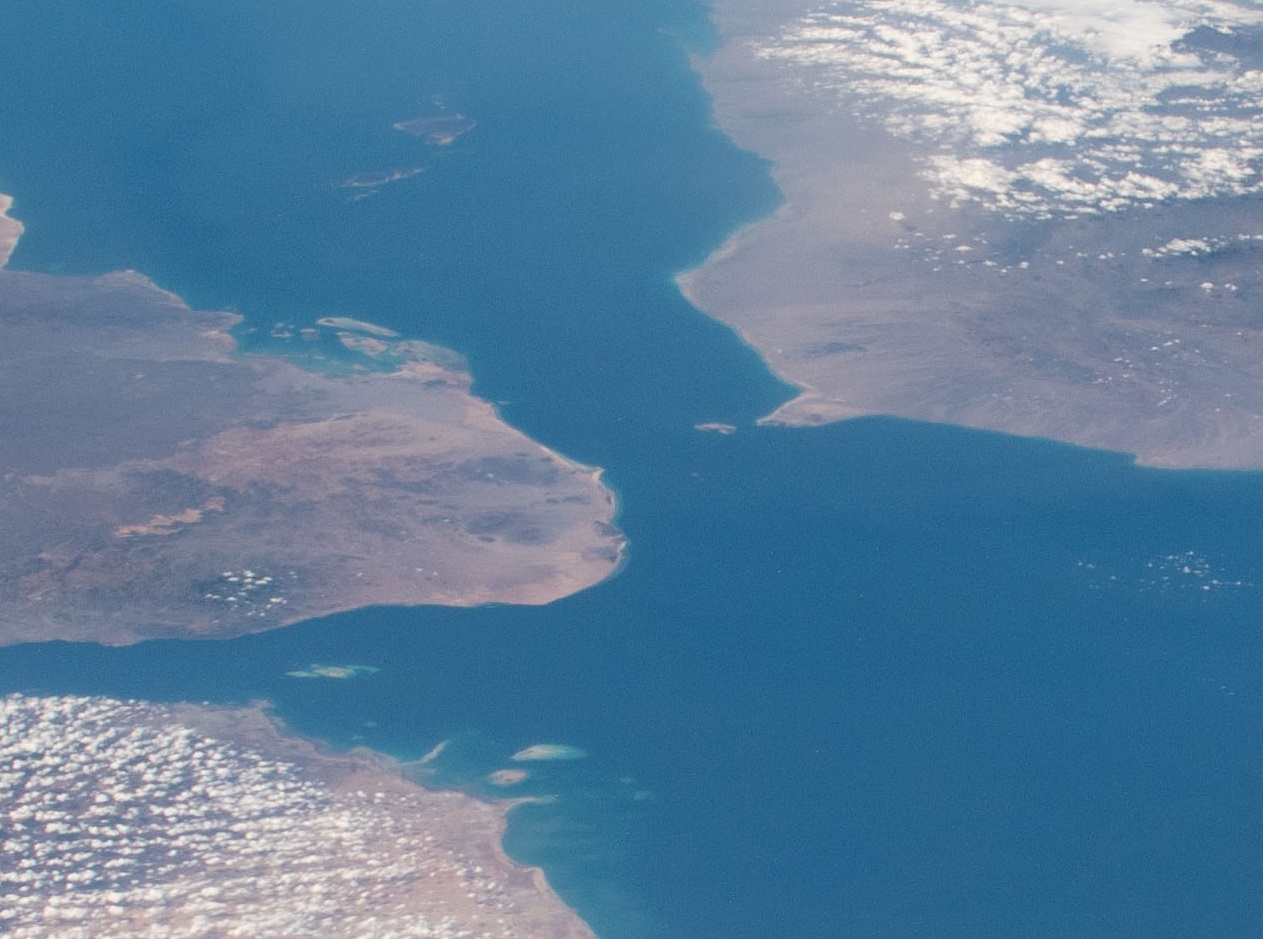Name
The strait takes its name from the dangers it encountered during its journey or, according to an Arab legend, from the many people who drowned in the earthquake that separates the Arabian Peninsula from the Horn of Africa.
In “Bab-el-Mandeb”, “Bab” means “door” while “Mandeb” means “lamentation” or “sorrow”.
Geography
Bab-el-Mandeb, located at the coordinates of 12°35’N 43°20’E between Northeast Africa and West Asia, is a natural strait located between Yemen, Djibouti, and Eritrea in the Arabian Peninsula. It separates Africa from the Arabian Peninsula in the Horn of Africa and connects the Red Sea to the Gulf of Aden. It covers an area of approximately 26 kilometers (16 mi) from Ras Menheli in Yemen to Ras Siyyan in Djibouti. Maximum width of 31 miles (50 km), Minimum width of 16 miles (26 km), Average depth of 609 ft (186 m).
The island of Perim divides the strait into two channels; the east of which, known as Bab Iskender (Alexander Strait), is 5.37 kilometers (3.34 mi) wide and 29 meters wide; It is 96 feet (16 fathoms) deep, while the western or Dact-el-Mayun has a width of 20.3 kilometers (12.6 miles) and a depth of 310 meters; 1,020 feet (170 fathoms). Near the coast of Djibouti lies a group of small islands known as the “Seven Brothers”. There is an inward surface current in the eastern channel and a strong outward undercurrent in the western channel.
It is one of the most important maritime trade routes in the world, connecting the Indian Ocean and Southeast Asia to the Mediterranean and Europe via the Suez Canal.
The geopolitical and geoeconomic importance of the Bab-el-Mandeb Strait and the Red Sea in maritime trade routes
The Red Sea, which connects the Mediterranean and the Indian Ocean, is one of the most important waterways in the world. This sea, which is mostly discussed in terms of the Suez Canal, is very important in geopolitical and geoeconomic terms with its role in maritime trade and energy transfer. The security and control of the Babülmandep Strait, located at the intersection of East Africa and the Middle East and the opening point of the Red Sea to the Indian Ocean, has pushed global and regional actors into a serious struggle.
Instability in Yemen and Somalia and piracy attempts in the Indian Ocean-Red Sea connection are also closely related to the geopolitical and geoeconomic importance of the Red Sea. In this context, the foreign policy strategies of the countries in the region, their relations with global and regional actors, and even the domestic political developments in these countries are also affected by the Red Sea-oriented competition and also affect competition.
Recently, the most emphasized issue in this region is the military bases acquired by various global/regional actors in the countries of the region. It can even be said that these actors are struggling to obtain bases in various regional countries.
The strait, which serves as a strategic connection between the Indian Ocean and the Mediterranean through the Red Sea and the Suez Canal, is a natural strait of high geopolitical importance due to the Suez Canal that was built later. When compromised for world trade, the Suez Canal becomes largely irrelevant.
Most of the oil and natural gas exports from the Persian Gulf passing through the Suez Canal or SUMED Pipeline pass through both Bab el-Mandeb and the Strait of Hormuz. Approximately 8% of the world’s oil transported by tankers passes through these straits.
Narrow channels are critical for global energy security and trade. The Bab el-Mandeb Strait is 28 miles wide at its narrowest point, limiting tanker traffic to two 2-mile-wide channels for incoming and outgoing shipments.
After the Suez Canal was built, the importance of the Bab el-Mandeb Strait increased. A strategic closure to maritime traffic could prevent tankers from the Persian Gulf from passing through the Suez Canal or reaching the SUMED Pipeline. It could force ships to divert towards the southern tip of Africa, increasing travel time and in turn increasing shipping costs.
It is estimated that in 2006, approximately 43 million barrels per day (6,800,000 m3/day) of the world’s total transported by tankers, 3.3 million barrels (520,000 m3) of crude oil, condensate, and refined petroleum products, passed through this strait. An estimated 6.2 million barrels of crude oil, condensate, and refined petroleum products flowed through the Bab el-Mandeb Strait to Europe, the United States, and Asia in 2018, an increase of 5.1 million barrels per day (b/d). The total oil flow through the Bab el-Mandeb Strait accounted for approximately 9% of the total oil (crude oil and refined petroleum products) traded by sea in 2017. About 3.6 million barrels a day moved north toward Europe; The other 2.6 million bbl/bbl flowed in the reverse direction, mostly to Asian markets such as Singapore, China, and India.
History
Paleoenvironmental and tectonic events during the Miocene created the Danakil Isthmus, a landscape that is the product of an extensive connection with Yemen. Fluctuations in eustatic sea level over the last 100,000 years have caused the straits to open and close. According to the recent single-origin hypothesis, the Bab-el-Mandeb straits probably witnessed the first migrations of modern humans. It is estimated that the oceans were much lower at that time and the straits much shallower or drier, allowing for a series of migrations along the southern coast of Asia. Some anthropologists think that about 60,000 years ago when the sea level was much lower than today, the homo sapiens species that makeup today’s humans spread out of Africa from this region and spread around the world.
According to Ethiopian Orthodox Tewahedo Church tradition, the Bab-el-Mandeb straits witnessed the first migrations of Semitic Ge’ez speakers to Africa. 1900 BC, approximately the same time as the Hebrew patriarch James. The Kingdom of Aksum was a major regional power in the Horn of Africa. Shortly before the rise of Islam, he expanded his rule beyond the straits with the conquest of the Himyar Kingdom.

